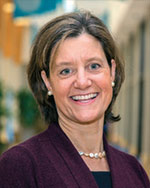Promoting a framework for age-friendly health systems
|
Leslie Pelton, MPA |
Leslie Pelton, Institute for Healthcare Improvement (IHI) senior director, found herself with a challenge: Only 10 percent of older adults in the United States are offered the best evidencebased care, despite a wealth of geriatric care models and significant financial contributions in research and program implementation by organizations like the John A. Hartford Foundation, a nonprofit coalition dedicated to improving the care of older adults.
“This is a classic problem we see at IHI: the ‘know-do’ gap — the difference between knowing the best evidence-based practices and doing it reliably, every time, for every adult,” Pelton explains.
The Creating Age-Friendly Health Systems initiative was launched to develop systems that measurably improve care for older adults while lowering costs. IHI and the John A. Hartford Foundation identified common elements across established models of care with the highest impact, then tapped health leaders including researchers and physicians to review 17 common components of care.
“We asked them to come back with five of the most important elements that could be reliably implemented across all care models,” Pelton says, “but they did us one better and provided four — the 4Ms.”
The 4Ms
The 4Ms are four key interventions essential to providing age-friendly care:
Initial findings from the primary care NP program survey show a variety of approaches to support NPs’ interest in rural primary care practice.
- What matters: Know and align care with each older adult’s specific health outcome goals and care preferences across settings of care, including end-of-life care.
- Medication: If medication is necessary, use age-friendly medications that do not interfere with what matters to the older adult, mobility, or mentation across settings of care.
- Mentation: Prevent, identify, treat, and manage dementia, depression, and delirium across settings of care.
- Mobility: Ensure older adults move safely every day to maintain function and do what matters.
The initiative recognized that some elements of the 4Ms were being implemented in some places, some of the time. But the effectiveness of the model depends on the consistency and scalability of the interventions.
“To close the know-do gap, the 4Ms must be able to be implemented by any care provider — not just gerontologists,” Pelton says. This is especially important in rural communities, where specialists are often in short supply.
Age-friendly health care in rural settings
Rural health care settings present unique challenges to older adults seeking care. Access to specialists and primary care may be an issue, with variables such as transportation, unemployment, and caregiver resources presenting additional barriers. In rural settings, the 4Ms provide a framework everyone in the care delivery team can follow. Focusing on social determinants of health and beginning with what matters to older adults can be game changing in providing age-friendly care.
“This is not unique to rural populations of older adults, but many people in that age group are not accustomed to talking about what matters to them and would not customarily stop a doctor to discuss what is important to them,” Pelton says. “While the framework is admittedly clinical, we do hope that it empowers patients. The 4Ms are person-centered by design.”
While defining what matters is key to the model, Pelton points out that the true innovation comes from the combined effect of all four interventions put into practice, all the time.
Accelerating a movement
“Creating Age-Friendly Health Systems is a movement, not a project,” Pelton says. “It’s about fundamentally changing and reorganizing how care is provided to older adults.” Currently, more than 400 teams in 49 states are working to implement the 4Ms.
Some systems are already following the 4M framework, and IHI can recognize them as age-friendly. For teams working to adopt the 4Ms, the online Action Community is an important resource.
“The Action Community is a virtual learning community where 75 teams from different systems come together to accelerate their adoptions by sharing experiences and accessing experts in each of the 4Ms,” Pelton explains. “Together in 2020, IHI and NRHA will be rolling out an Action Community tailored to the needs of rural hospitals and providers so that rural health care systems can join the movement and accelerate their adoption of the 4Ms.”
The initiative’s goal is for all older adults to receive age-friendly care, and this is only possible through a social movement among care providers. “We’ve touched a spark with physicians,” Pelton says. “We have heard from physicians that the 4Ms have reinvigorated and changed their practice.”
Such enthusiasm will likely help the initiative meet its first milestone of providing age-friendly care to 20 percent of older adults by Dec. 31, 2020, through the participation of 1,000 hospitals and 1,000 primary care practices.
Learn more
For more information about the 4Ms and Creating Age-Friendly Health Systems, visit IHI.org/agefriendly.

